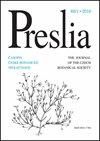Soil moisture and a legacy of prehistoric human activities have contributed to the extraordinary plant species diversity of grasslands in the White Carpathians
IF 4.4
2区 生物学
Q1 PLANT SCIENCES
引用次数: 7
Abstract
The factors that determine the unique species richness and composition of some temperate grasslands are poorly known. Uniqueness of the extraordinarily species-rich grasslands in the White Carpathian mountain range (Czech Republic, Slovakia), with many disjunct occurrences of species, have been previously attributed to intermittently wet deep soils, which facilitate the co-occurrence of steppe and wet-grassland species, and Holocene continuity of open land, resulted in large species pools. Based on a detailed investigation of 23 well-preserved regularly mown grasslands differing in their vegetation composition and species richness, we tested the relative importance of the hypothetical determinants of compositional variability within semi-dry grasslands. For the first time we included measurements of seasonal moisture at different soil depths and landscape differences in the intensity of the effect of prehistoric humans. Soil moisture was measured using the frequencydomain reflectometry based Profile Probe PR2 sensor at depths of 10, 20, 30, 40 and 60 cm in the soil, repeatedly every four weeks from April to November. Soil samples were taken from the same depths in order to determine soil basicity and nutrient content. As a proxy of the intensity of the effect of prehistoric human activities, mean distances between sampled localities and the five nearest Neolithic or Aeneolithic settlements were used. The species richness was best explained by mean soil moisture, which increased towards the most species-rich grasslands, whereas the distance from prehistoric settlements had no effect. Basicity, moisture and the distance from prehistoric settlements had significant conditional effects on species composition. There was a high frequency of species of intermittently wet soils, thermophilous oak forests and forest fringes in the most valuable grasslands, which are located mostly in the south-western part of the area where the soils were moister and closer to prehistoric settlements, but the seasonal variation in moisture was not high. We conclude that coexistence of species from different habitats is dependent on regular management and high soil moisture throughout the growing season. Due to intermediate moisture conditions that are tolerated by multiple ecological groups of species, many species may locally coexist and form a species-rich grassland community of unique species composition. In addition, prehistoric human activities contributed to landscape openness and helped maintain a forest-steppe species pool during the Holocene forest optimum. Our results indicate that although this historical determinant shapes predominantly the species composition pattern, the extraordinarily species-rich spots are determined rather by abiotic factors, such as intermediate moisture and biotic interactions resulting from the type and duration of management practices. Preslia 92: 35–56, 2020 35土壤湿度和史前人类活动的遗产促成了白色喀尔巴阡山脉草原上非凡的植物物种多样性
决定某些温带草原独特物种丰富度和组成的因素尚不清楚。白色喀尔巴阡山脉(捷克共和国,斯洛伐克)物种丰富的草原的独特性,以及许多物种的不间断出现,以前被归因于间歇性潮湿的深层土壤,这有利于草原和湿草地物种的共同出现,以及全新世开放土地的连续性,导致了大型物种池。通过对23个保存完好的定期刈割草地的植被组成和物种丰富度的详细调查,我们验证了半干旱草地中组成变异的假设决定因素的相对重要性。我们第一次包括了不同土壤深度的季节性湿度测量和史前人类影响强度的景观差异。采用基于频域反射法的Profile Probe PR2传感器在土壤10、20、30、40和60 cm深度测量土壤水分,每四周重复一次,从4月至11月。为了测定土壤的碱度和养分含量,从同一深度取了土壤样品。作为史前人类活动影响强度的代表,采样地点与五个最近的新石器时代或新石器时代定居点之间的平均距离被使用。物种丰富度最好用平均土壤湿度来解释,在物种最丰富的草原上,土壤湿度增加,而与史前定居点的距离没有影响。碱度、湿度和与史前聚落的距离对物种组成有显著的条件影响。间断性湿润土壤、喜热栎林和森林边缘种分布频率高,主要分布在土壤较湿润且接近史前聚落的西南地区,但季节湿度变化不高。我们得出结论,不同生境物种的共存依赖于整个生长季节的定期管理和高土壤湿度。由于多种生态类群可以承受的中等湿度条件,许多物种可能在局部共存,形成物种组成独特的物种丰富的草地群落。此外,史前人类活动有助于景观开放,并有助于维持全新世森林最佳状态下的森林-草原物种池。我们的研究结果表明,尽管这一历史决定因素主要决定了物种组成格局,但物种异常丰富的地点更多地是由非生物因素决定的,例如由管理实践的类型和持续时间导致的中间湿度和生物相互作用。中国农业科学学报(自然科学版),2016
本文章由计算机程序翻译,如有差异,请以英文原文为准。
求助全文
约1分钟内获得全文
求助全文
来源期刊

Preslia
生物-植物科学
CiteScore
5.20
自引率
29.40%
发文量
8
审稿时长
>12 weeks
期刊介绍:
Preslia is a peer-reviewed scientific journal publishing original research papers on plant systematics, morphology, phytogeography, ecology and vegetation science, with a geographical focus on central Europe. The journal was founded in 1914 and named in honour of brothers Jan Svatopluk Presl (1791–1849) and Karel Bořivoj Presl (1794–1852), outstanding Bohemian botanists. It is published quarterly by the Czech Botanical Society.
 求助内容:
求助内容: 应助结果提醒方式:
应助结果提醒方式:


